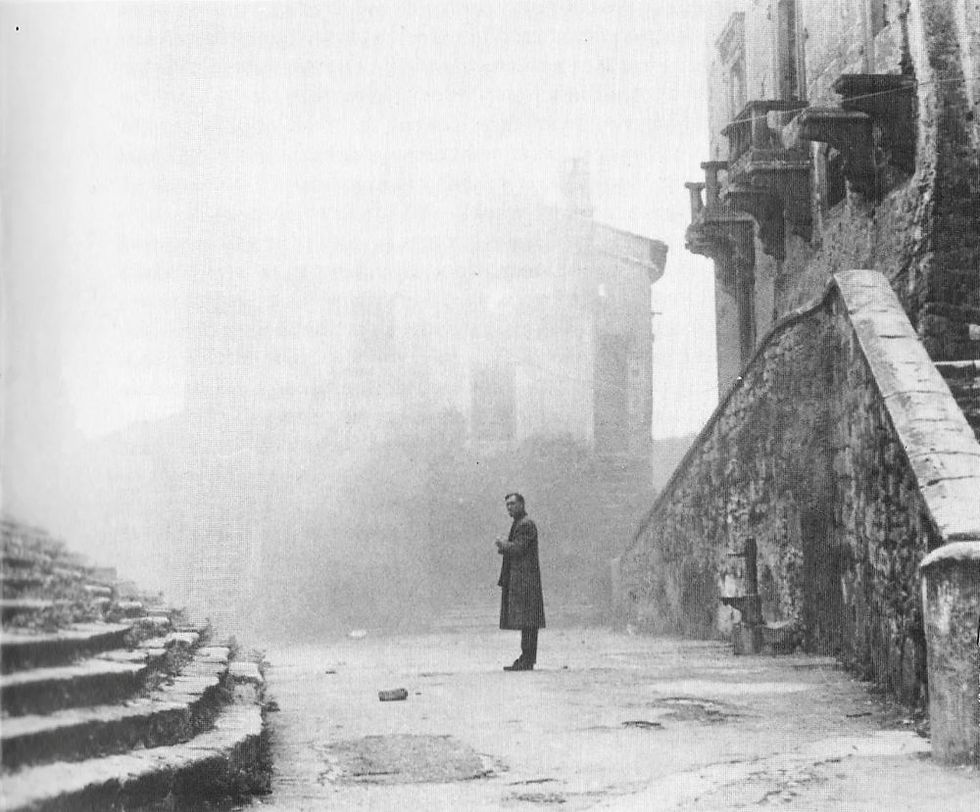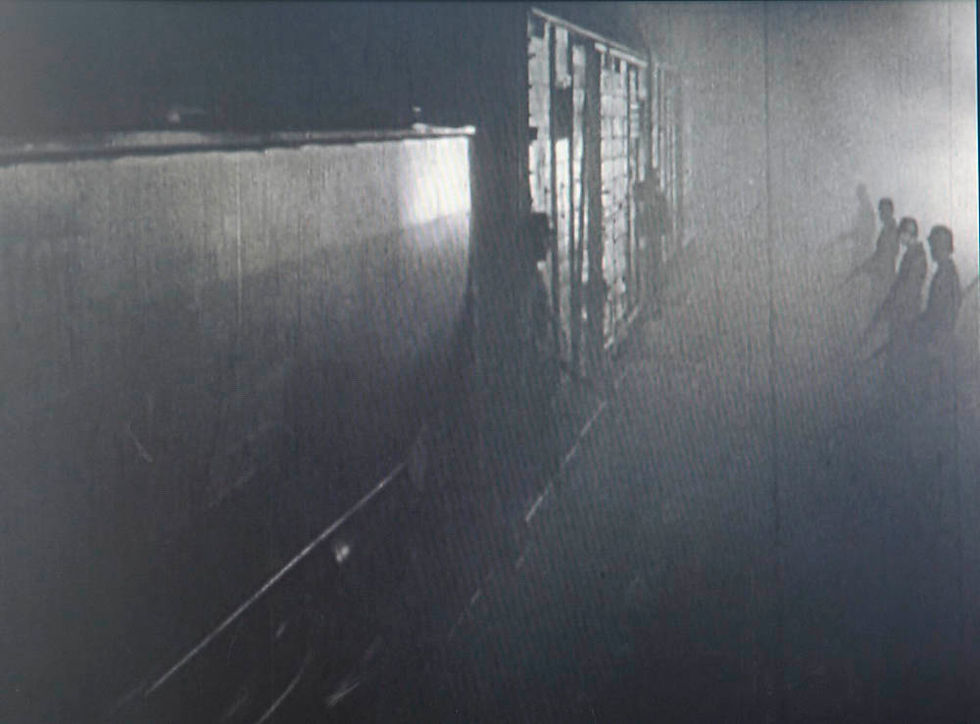- -
- Oct 28
- 8 min read

SILVER SCREEN
A THEORY OF MIST: CINEMA AND FOG
LEONARD I. STRICKLANT
October 28, 2025
Every film begins with a blur—an image trying to find itself. This piece looks at what happens when movies embrace that hesitation, when sight falters and meaning drifts. From silent apparitions to neon cities and spectral landscapes, it follows the strange intelligence of weather on screen: how the uncertain becomes beautiful, and how the unseen teaches us what to look for.
The cinema has always had trouble with clarity. Even before the first audience gathered to watch the Lumière brothers’ workers leave the factory in 1895, light had to be filtered, diffused, and tamed to make sense on film. The earliest cinematographers knew what philosophers already suspected: Too much light destroys vision. What we see depends on what resists seeing. In this sense, fog is not an obstacle but a condition of cinema, a reminder that the image itself is a form of weather.
In Nosferatu (1922), F. W. Murnau turned fog into a kind of moral substance. The air of Wisborg seems infected; shapes drift without edges, and evil moves faster than the people who spread it. The vampire is almost an afterthought—the real horror is the loss of definition, the surrender of the world’s outline. A decade later, Carl Theodor Dreyer’s Vampyr (1932) would take that uncertainty further. Its plot dissolves in a milky haze that feels less like atmosphere than consciousness itself. Dreyer’s fog behaves like a mind: hesitant, dream-ridden, susceptible to light but never mastered by it.

Nosferatu (F. W. Murnau, 1922)
Where light forgets its edges and evil learns to breathe.
By mid-century, fog had become the conscience of postwar cinema. Carol Reed’s The Third Man (1949) shrouds Vienna in a vapor that seemed to rise from moral confusion itself. When Orson Welles finally appears, grinning in the half-light, he seems born of the mist, a condensation of guilt and charm. The chiaroscuro of film noir—humid alleys, backlit lamplight—is not realism but repentance, the screen confessing that clarity no longer corresponds to truth.
Akira Kurosawa transformed this moral atmosphere into metaphysics. In Throne of Blood (1957), his retelling of Macbeth, fog becomes destiny. The mountain forest folds in on itself until every step forward is also backward. Kurosawa filmed on the slopes of Mount Fuji, where real fog rolled unpredictably. The weather refused choreography, so the crew waited for hours, surrendering the script to the air. The result is a spectacle of futility—the clearer the path appears, the closer it leads to ruin.

Throne of Blood (Akira Kurosawa, 1957)
The mountain breathes in judgment; ghosts arrive before the living understand why.
Andrei Tarkovsky inherited that lesson. His films breathe. In Andrei Rublev (1966), Mirror (1975), and Nostalghia (1983), fog is neither concealment nor symbol but a visible form of time. The camera moves slowly enough for vapor to acquire thought. The landscapes exhale; memory condenses. To watch a Tarkovsky scene unfold in mist is to experience duration as texture—the soul negotiating with weather.

Nostalghia (Andrei Tarkovsky, 1983)
The air itself remembers; exile is a kind of weather.
Other filmmakers discovered that fog could soften cruelty. The farewell scene in Michael Curtiz’s Casablanca (1942) was shot on a small back lot, the plane a miniature, the mist entirely artificial. Yet the vapor saves the film from melodrama. It turns moral calculation into emotion, war into sentiment, propaganda into myth. Fog diffuses the harshness of choice.

Casablanca (Michael Curtiz, 1942)
The fog spares them from truth—love endures in half-light.
By 1956, fog had acquired its own memorial. Alain Resnais titled his documentary Night and Fog, borrowing the Nazi term Nacht und Nebel for prisoners made to disappear. Resnais filmed the abandoned camps under an indifferent sky, the camera gliding past barbed wire and grass reclaiming stone. In one shot, morning mist drifts across an empty yard. It does not accuse; it forgets. The image is unbearable precisely because it refuses pathos. What remains unspeakable must remain somewhat unseen.

Night and Fog (Alain Resnais, 1956)
The mist at Auschwitz does not weep—it remembers by forgetting.
If European filmmakers treated fog as moral weather, their East Asian contemporaries saw in it something more animistic, a threshold between worlds. Kaneto Shindō’s Onibaba (1964) traps its two women in tall reeds and shifting mist, the air charged with hunger and lust. The swamp breathes like a conscience. The fog there is erotic, but also judicial—it hides nothing, it waits.
Masaki Kobayashi’s Kwaidan (1965) turns fog into paint. Every frame is composed, theatrical, saturated with color that refuses realism. Spirits materialize through mist as if via brushstrokes, and the visible world reveals itself as artifice. In A Touch of Zen (King Hu, 1971), combat in the bamboo forest takes place in morning haze so luminous it feels sacred. The mist is rhythm, not obstacle. Clarity would ruin the choreography.

Kwaidan (Masaki Kobayashi, 1965) Fog as lacquer: ghosts painted into visibility.
Sand replaces fog in Woman in the Dunes (Hiroshi Teshigahara, 1964). The distinction hardly matters. Both erase the horizon, both turn survival into ritual. Teshigahara’s granular world is a parable of repetition: every grain a thought, every motion futile. The camera peers through the dust until vision itself begins to suffocate.
By 1980, when John Carpenter released The Fog, the element had turned spectral. The ghosts that return to avenge a shipwreck are almost secondary; the real protagonist is the weather itself. Carpenter’s fog glows unnaturally, both menace and beauty, a luminous guilt rolling through small-town streets. In its movement there is intelligence, a kind of moral tide. The revenge may be supernatural, but the mood is recognizably human: the past refusing to clear.

The Fog (John Carpenter, 1980) Evil arrives as climate—soft, luminous, and already inside.
Fog also entered modern urbanism. In Ridley Scott’s Blade Runner (1982) and its sequel by Denis Villeneuve (2017), haze no longer comes from nature but from industry. Pollution and neon merge into a perpetual twilight. This is fog as data: visibility overwhelmed by information. The future, it turns out, is not bright but saturated. The old, meteorological fog concealed; the digital one exposes everything at once. Too much light has the same effect as none.
The impulse to see everything—to illuminate, to document—was always cinema’s ambition, and its danger. Fog corrects it. It slows the compulsion to understand. It insists that beauty, like truth, requires a veil. Philosophers might call this epistemological modesty; filmmakers simply call it atmosphere. The best directors have known that images, like people, lose depth when overlit.
There is something devotional about the patience fog demands. In Kurosawa’s Dreams (1990), a child enters a mountain blizzard and meets ghosts of the lost. The storm softens into mist; the living and dead share the same breath. The sequence plays like a miniature theology. Revelation arrives only when vision fails.

Taxi Driver (Martin Scorsese, 1976)
The streets sweat guilt; redemption rises only as steam.
Even genres that seem immune to introspection find themselves redeemed by weather. Consider horror: Carpenter’s mist, the marsh vapors of Onibaba, the blue haze of Kwaidan. Terror thrives not in darkness but in partial light, where every shape might be a mistake. Or romance: Wong Kar-wai’s In the Mood for Love (2000) replaces fog with cigarette smoke, the urban equivalent. In New York, it becomes steam—manholes exhaling like insomnia, the streets of Taxi Driver (1976) breathing their own unease. The vapor there is municipal, not meteorological—a by-product of heat and pressure, a city’s private weather system. It belongs to the same family of obscurity, the same moral humidity, that binds lovers in Hong Kong and loners in Manhattan.

In the Mood for Love (Wong Kar-wai, 2000) Cigarette smoke, the urban twin of mist—memory rehearsing intimacy.
In these films, mist behaves like conscience. It rises unbidden, it complicates, it refuses resolution. One could chart a history of cinema through its fog, from spiritual uncertainty to moral ambiguity to digital noise. Each era produces its own opacity.
There is a practical side to all this. Fog hides imperfections, fuses disparate elements, gives coherence to chaos. Directors know that a little haze in the lens can make a cheap set feel eternal. But beneath the technique lies a metaphysical intuition: Clarity is a trap. The perfectly visible world is a perfectly dead one.
This is why fog is both democratic and tragic. It equalizes detail; it removes hierarchy. Mountains and alleys share the same softness. Yet in doing so, it reminds us that distinction—the sharpness of things—is what consciousness is made of. To live in fog is to sense the limits of thought. The camera records that hesitation faithfully.
In Night and Fog, the mist at Auschwitz does not absolve, but acknowledges the insufficiency of light. In Nostalghia, it sanctifies exile. In The Third Man, it implicates. In The Fog, it punishes. Each time, the weather carries memory more honestly than dialogue could.
Modern technology has little patience for such ambiguity. The 4K image, the HDR palette, the infinite zoom of the drone shot—all promise a kind of forensic clarity. Yet the more perfectly we see, the less the image feels alive. Digital light flattens emotion. It refuses the half-truths that make cinema human. The cloud that stores our films now mimics the fog they once depicted, but without mystery.
And still, some filmmakers resist. In Apichatpong Weerasethakul’s Uncle Boonmee Who Can Recall His Past Lives (2010), mist gathers around the jungle as the living dine with the dead. In Tsai Ming-liang’s Goodbye, Dragon Inn (2003), the projection beam itself becomes fog, drifting through the empty theater like memory refusing to disperse. These films restore opacity as an ethic: to see less, and thereby to feel more.

Uncle Boonmee Who Can Recall His Past Lives (Apichatpong Weerasethakul, 2010) The dead attend quietly, their eyes small lanterns in the jungle.
Perhaps this is what cinema was always meant to do—to teach us how to live with partial knowledge. The screen gives us not the world, but its vapor. What matters is not resolution but suspension, that slow breathing between clarity and confusion.
When the film ends and the lights rise, a faint haze still hangs in the room—dust, heat, air disturbed by light. For a moment, we see what the image has left behind: not certainty, not revelation, but the ghost of perception itself. The audience stands, blinking, as if waking from weather.
Fog is not an accessory to cinema; it is its conscience. Every act of seeing depends on what remains unseen. It a clear image is merely information, a misted one is experience. The true miracle of film is not that it shows us the world, but that it teaches us to accept its blur.
In the end, the theory is simple enough. The world, like the screen, exists only in diffusion. We live among vapors of meaning, pretending they will one day clear. They will not. And if cinema has taught us anything, it is that this is not a failure but a gift. For the briefest moment, as the image trembles through mist, we see what vision really is: the art of not quite seeing.
Leonard I. Stricklant (b. 1969 in Providence, Rhode Island) writes about movies the way meteorologists talk about storms: technically precise, faintly alarmed, and secretly in love with disaster. He studied archeology at Brown and film theory at NYU, where he reportedly turned in a thesis comparing fog machines to moral ambiguity. Stricklant lives in San Francisco, tweets only in lowercase, and maintains that the best movie ever made is still a tie between “Metropolis” (1927) and “Speed 2: Cruise Control” (1997). One invented the future; the other proved we couldn’t steer it.
Cover image: Blade Runner 2049 (Denis Villeneuve, 2017) Light becomes information; clarity drowns in data.

Comments